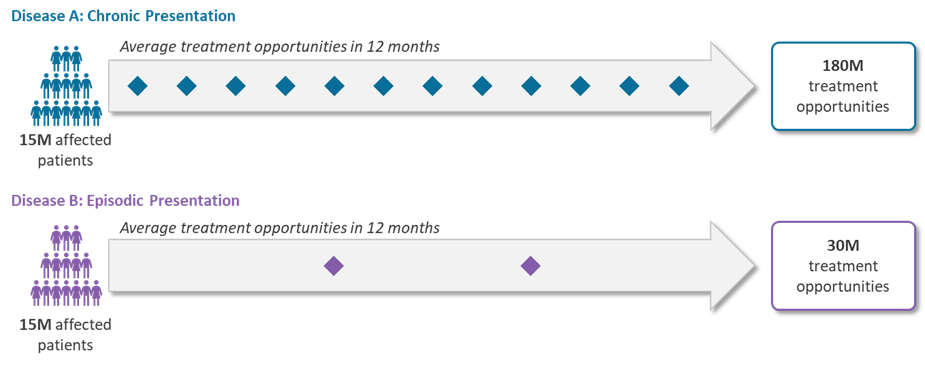Are valuable opportunities being deprioritised by pharma due to sub-optimal interpretation of a disease’s addressable patient population size?
When prioritising opportunities to deliver innovative solutions to patients, what makes one disease more attractive than another for the pharmaceutical manufacturer? Evaluating market attractiveness is an important step and often represents the starting point to narrow down a preliminary list of potential disease targets. While there are many factors that will influence the relative attractiveness of a particular market, a natural first consideration is the total amount of patients a new therapeutic offering could reach. In other words, for each indication of interest, how many patients comprise each addressable patient population? Without a careful approach to determining this answer, the conclusion has the potential to be severely misleading. Given the complexities associated with comparing the population sizes of different diseases, is it possible that pharma companies could overlook – or even deprioritise – a valuable opportunity?
Below, we discuss a two-step approach for evaluating addressable patient populations and using the insights to generate reliable assumptions for an indication prioritisation exercise.
Step 1: Determine the Role and Recipient of the Asset
To accurately estimate the total opportunity available to an asset, it is critical to understand the specific context of its envisioned role as it pertains to each indication being assessed. Defining a role that is too broad – for example, “treatment of pain” – is unhelpful and problematic, leaving room for misinterpretation and misguided commercial expectations. To dig deeper into the envisioned role for an asset, there are several questions to consider to help define this with sufficient specificity:

The “WHAT” – example considerations:
- What is the intended therapeutic impact of the asset (e.g., relief of active symptoms/episodes; prevention of symptoms; cure of disease)?
- Would administration of the treatment be lifelong or only short-term?
- Would the asset be replacing or adding on to existing therapies?
Inherently linked to the therapeutic role of the asset is the target recipient of the asset. The choice of target population creates a foundation that informs the remainder of the indication analysis, influencing everything from addressable population size, to competitive dynamics, to trial execution feasibility. It is therefore critical to define the target patient segment at the starting point of the analysis, beginning with exploration of the following questions:
The “WHO” – example considerations:
- Would eligible patients be defined based on their disease characteristics, such as severity or presence of biomarkers?
- Would eligible patients be defined based on their non-disease-specific characteristics, such as age or comorbidities?
- Would eligible patients be required to first demonstrate failure to a different therapy?
Defining a target patient group that is as precise as possible will help to support the accuracy of the analysis and, later down the line, will also reduce hurdles to achieving strong product differentiation. Unfortunately, depending on the stage of an asset, it is not always possible to articulate the optimal level of detail regarding the “who” and “what”. In these cases, when it is unclear where the true opportunity lies, building scope within the analysis to simultaneously evaluate multiple therapeutic role scenarios will help to proactively address any key uncertainties.
Step 2: Identify the Correct Metric to Determine the Scale of Opportunity
“How many patients are affected by each of the diseases we are looking at?” – a question that will undoubtedly be on the minds of stakeholders awaiting the outputs of an indication prioritisation exercise. The most likely answer? It’s complicated. This inquiry may seem simple on the surface, but in reality it contains many layers – layers that cannot be ignored for the purpose of analysing the available opportunity between different indications.
When comparing patient volumes, epidemiology alone does not translate into a clear representation of commercial opportunity and scaling potential. Although it may be a tempting shortcut, there are several issues with drawing conclusions based on the total “affected” population. An obvious but expected challenge relates to the potential need to compare chronic and episodic conditions, typically measured in terms of prevalence and incidence, respectively.
Consider the following: If you are prioritising cardiology opportunities and need to evaluate the annual treatable population, what is the fairest way to compare the addressable populations for chronic heart failure and acute myocardial infarction? Or, shifting into respiratory, how could you level the field to compare the addressable populations of severe asthma with episodes of pneumonia? In these examples, we are dealing with patients requiring lifelong management alongside patients who may only require sporadic bouts of management, meaning the commercial opportunity on a per-patient basis will likely look considerably different and must be accounted for.
A further challenge relates to the potential for multiple angles of care embedded within a single condition. Consider cystic fibrosis (CF): CF patients require chronic treatment to improve their lung function and prevent infections. However, a subset of patients will experience acute exacerbations related to their CF and will require different treatments to resolve an active episode. In the future, CF patients may have the option to pursue gene therapy and potentially cure their disease entirely.
The multiple theoretical treatment settings associated with CF illustrate why acknowledgement of total affected patients alone does not necessarily translate into a proxy for commercial opportunity. A preventative agent provided chronically to reduce acute episode frequency has a very different addressable patient population compared to an agent designed to reduce the severity of a single active acute episode. Furthermore, curative treatments, such as gene therapy, will require an entirely distinct revenue model.
The “WHEN” – accounting for treatment frequency:
Calibrating the addressable populations to enable direct comparison is essential to avoid misleading conclusions. Given the possible need to simultaneously evaluate both chronic and episodic diseases as well as long-term, short-term, and curative treatment settings, it could be useful to focus on a different metric: treatment opportunities. The annual number of treatment opportunities reflects both the number of patients affected by a condition as well as the frequency at which they would be expected to receive the asset. This allows important clarifications to be brought into light, enabling informed decision-making aligned to the specific goals for the asset in focus.

Concluding Thoughts: For the purposes of indication prioritisation, comparing the addressable patient populations of the different indications of interest is essential to do, but may be difficult to do well. By clearly outlining the what, who, and when as it relates to the asset within each indication being explored – that is: the therapeutic role, the target patient segment, and the resulting number of treatment opportunities – a levelled field for comparison across indications can be established and a well-informed addressable patient population analysis can proceed.
Join us as we continue our series on key considerations related to indication prioritization; in our next piece, we take a look at how to analyze unmet needs to drive opportunity.


